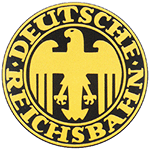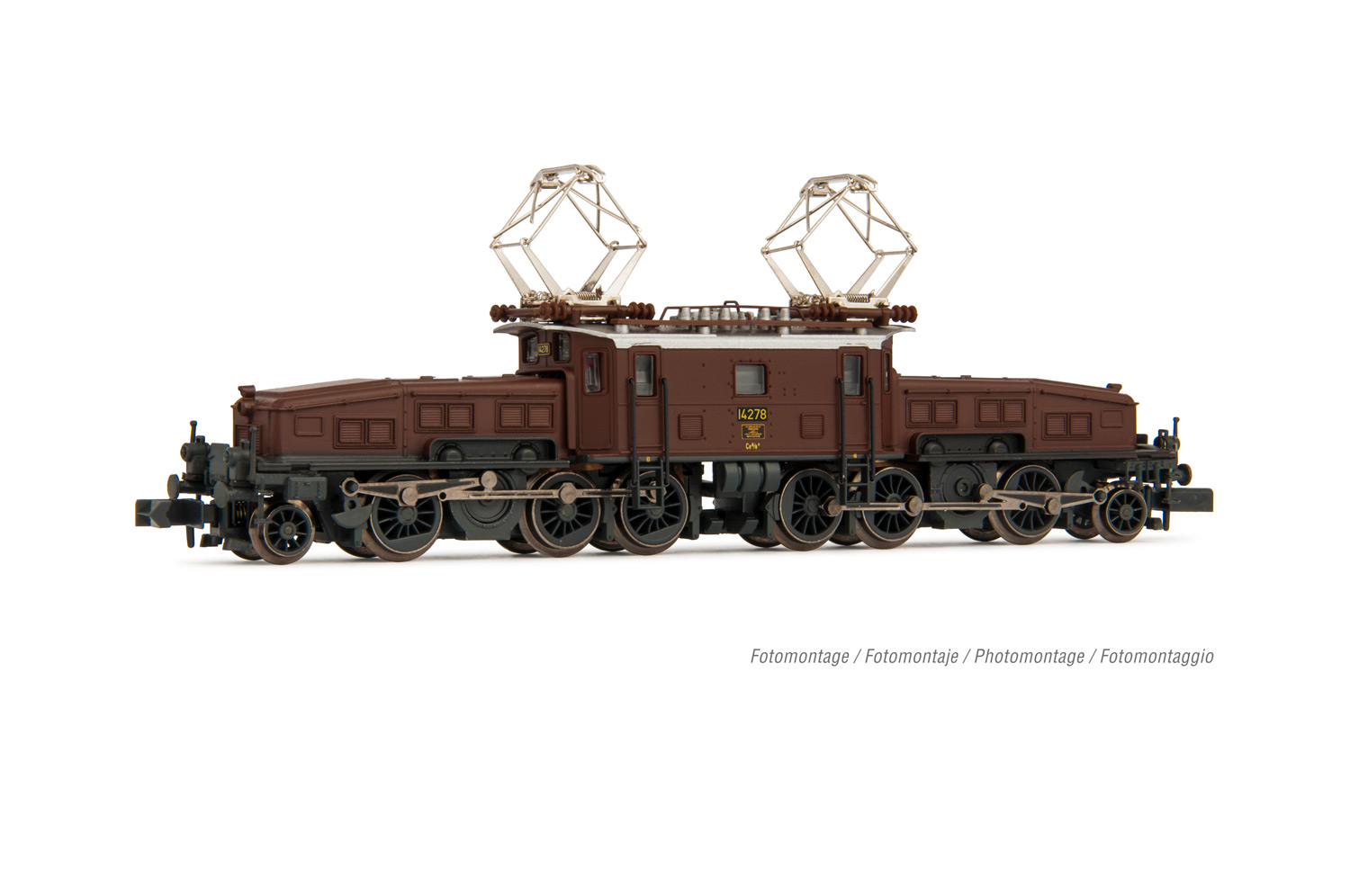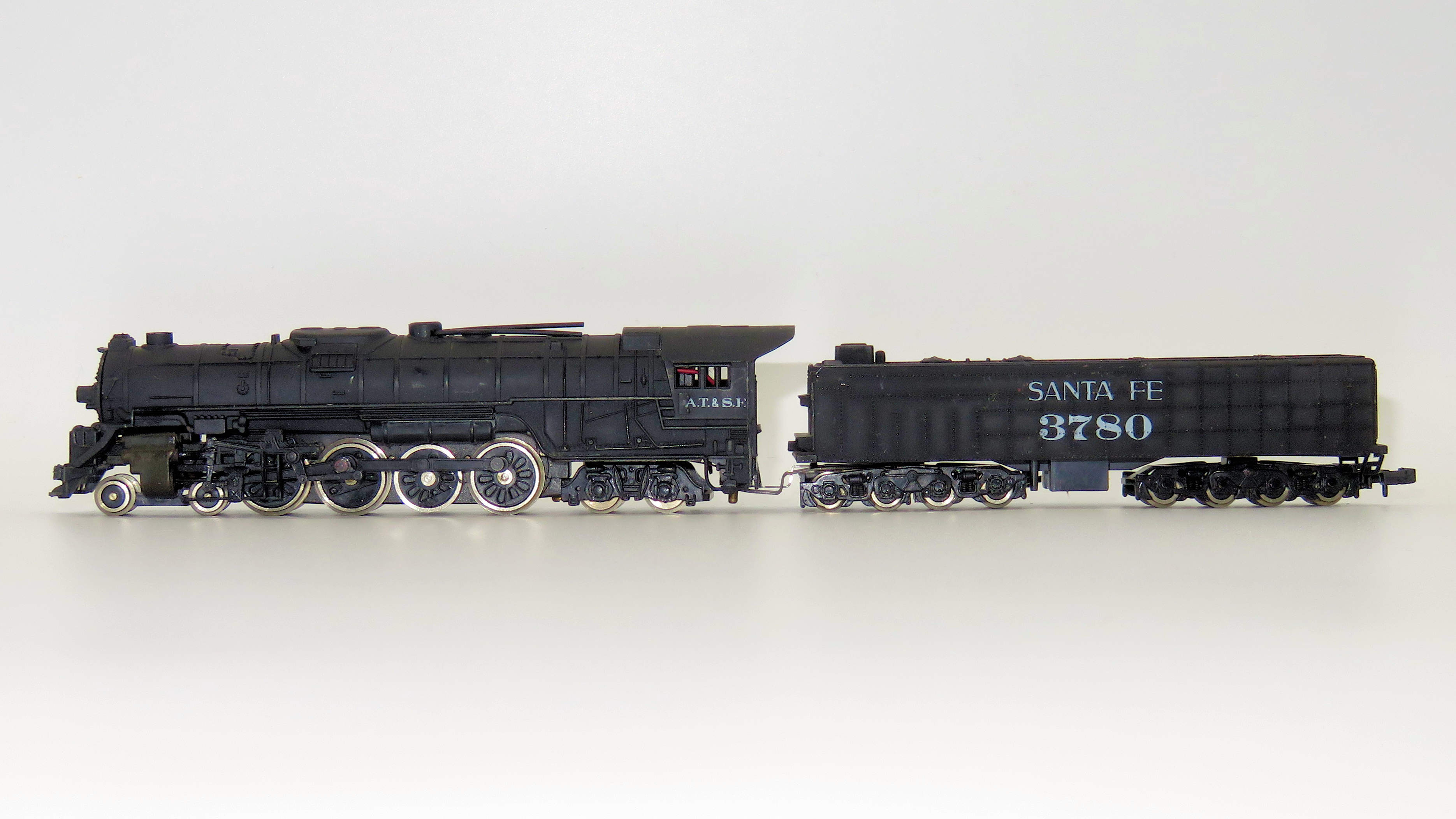Specific Item Information: We are unsure whether this item was actually created in N Scale. Spur N says it was never produced but other sources claim it was. Furthermore, the image we found appears to be N Scale.
Prototype History: The Bavarian Class Gt 2×4/4 (bayerische Gt 2x4/4) engine of the Royal Bavarian State Railways (Königlich Bayerische Staats-Eisenbahnen or K.Bay.Sts.B.), was a heavy goods train tank locomotive of the Mallet type. It was later designated the DRG Class 96 (Baureihe 96) by the DRG, DB and DR.
The Gt 2x4/4 Mallet locomotive was equipped with two sets of compound-configured running gear, the front one, pivoted on a 15 cm thick coupling pin, had large low-pressure cylinders, and the rear one, which was fixed, had smaller high-pressure cylinders. Both had one driven and three coupled axles. The designer of this heavy locomotive was the then senior engineer and director at Joseph Anton von Maffei, Anton Hammel, (1857-1925), who had also developed the famous S 3/6. Between 1913 and 1914 the first series of 15 vehicles was procured and they entered service in 1914. The locomotives caused quite a stir at that time and could be seen at the railway exhibitions frequently held in those days (e.g. the 1922 transport exhibition in Munich) - and, like the S 3/6, they were often painted with a blue or ochre yellow photographic livery and adorned with a crowned chimney. As the first one of the second series, no. 5766 (96 016) was even spruced up with brass bands on the crowned chimney and boiler as well as brass decorations on its front cylinders, and certainly made an impression. A similar thing was carried out on the same locomotive after the rebuilding of the second series in 1926. Otherwise, the first series had a narrow chimney with a cap similar to the Prussian P 8. The operational livery of the K.Bay.Sts.B. locomotives was green with yellow lettering and a black chassis.
The Gt 2x4/4 Mallet locomotive was equipped with two sets of compound-configured running gear, the front one, pivoted on a 15 cm thick coupling pin, had large low-pressure cylinders, and the rear one, which was fixed, had smaller high-pressure cylinders. Both had one driven and three coupled axles. The designer of this heavy locomotive was the then senior engineer and director at Joseph Anton von Maffei, Anton Hammel, (1857-1925), who had also developed the famous S 3/6. Between 1913 and 1914 the first series of 15 vehicles was procured and they entered service in 1914. The locomotives caused quite a stir at that time and could be seen at the railway exhibitions frequently held in those days (e.g. the 1922 transport exhibition in Munich) - and, like the S 3/6, they were often painted with a blue or ochre yellow photographic livery and adorned with a crowned chimney. As the first one of the second series, no. 5766 (96 016) was even spruced up with brass bands on the crowned chimney and boiler as well as brass decorations on its front cylinders, and certainly made an impression. A similar thing was carried out on the same locomotive after the rebuilding of the second series in 1926. Otherwise, the first series had a narrow chimney with a cap similar to the Prussian P 8. The operational livery of the K.Bay.Sts.B. locomotives was green with yellow lettering and a black chassis.
Road Name History:  The Deutsche Reichsbahn, also known as the German Reich Railway or the German Imperial Railway, was the name of the German national railway created from the railways of the individual states of the German Empire following the end of World War I.
The Deutsche Reichsbahn, also known as the German Reich Railway or the German Imperial Railway, was the name of the German national railway created from the railways of the individual states of the German Empire following the end of World War I.
The company was founded in 1920 as the Deutsche Reichseisenbahnen when the Weimar Republic, formally known as Deutsches Reich (German Reich, hence the usage of the Reich in the name of the railway), took national control of the German railways, which had previously been run by the German states. In 1924 it was reorganised under the aegis of the Deutsche Reichsbahn-Gesellschaft (DRG), a nominally private railway company, which was 100% owned by the German state. In 1937 the railway was reorganised again as a state authority and given the name Deutsche Reichsbahn (DRB). After the Anschluss in 1938 the DR also took over the Bundesbahn Osterreich (BBO, Federal Railway of Austria).
The East and West German states were founded in 1949. East Germany took over the control of the DR on its territory and continued to use the traditional name Deutsche Reichsbahn, while the railway in West Germany became the Deutsche Bundesbahn (DB, German Federal Railway). The Austrian Osterreichische Bundesbahnen (OBB, Austrian Federal Railways) was founded in 1945, and was given its present name in 1947.
In January 1994, following the German union, the East German Deutsche Reichsbahn merged with the West German Deutsche Bundesbahn to form Germany's new national carrier, Deutsche Bahn AG, technically no longer a government agency but still a 100% state-owned joint stock company.

The company was founded in 1920 as the Deutsche Reichseisenbahnen when the Weimar Republic, formally known as Deutsches Reich (German Reich, hence the usage of the Reich in the name of the railway), took national control of the German railways, which had previously been run by the German states. In 1924 it was reorganised under the aegis of the Deutsche Reichsbahn-Gesellschaft (DRG), a nominally private railway company, which was 100% owned by the German state. In 1937 the railway was reorganised again as a state authority and given the name Deutsche Reichsbahn (DRB). After the Anschluss in 1938 the DR also took over the Bundesbahn Osterreich (BBO, Federal Railway of Austria).
The East and West German states were founded in 1949. East Germany took over the control of the DR on its territory and continued to use the traditional name Deutsche Reichsbahn, while the railway in West Germany became the Deutsche Bundesbahn (DB, German Federal Railway). The Austrian Osterreichische Bundesbahnen (OBB, Austrian Federal Railways) was founded in 1945, and was given its present name in 1947.
In January 1994, following the German union, the East German Deutsche Reichsbahn merged with the West German Deutsche Bundesbahn to form Germany's new national carrier, Deutsche Bahn AG, technically no longer a government agency but still a 100% state-owned joint stock company.
Brand/Importer Information: Founded in 1906 by Karl Arnold in Nürnberg, K. Arnold & Co. began its life producing tin toys and related items. They produced an extensive line of model ships, doll house items and other toys. In 1935, K. Arnold & Co. hired Max Ernst as their managing director. Ernst, not to be confused with the German realist artist of the same name, was a significant factor in the future of Arnold.
On Max Ernst's 1976 retirement, Arnold employed perhaps 200 to 250 people, using three facilities in the Nuernberg area. The Company continued under family control until 1995, when Arnold went into bankruptcy and was sold to Rivarossi of Italy. Rivarossi, in turn, also went bankrupt, leading to the sale of all assets to Hornby of the United Kingdom. Production is carried out in China.
From Wikipedia
On Max Ernst's 1976 retirement, Arnold employed perhaps 200 to 250 people, using three facilities in the Nuernberg area. The Company continued under family control until 1995, when Arnold went into bankruptcy and was sold to Rivarossi of Italy. Rivarossi, in turn, also went bankrupt, leading to the sale of all assets to Hornby of the United Kingdom. Production is carried out in China.
From Wikipedia
Item created by: gdm on 2018-01-15 13:06:47
If you see errors or missing data in this entry, please feel free to log in and edit it. Anyone with a Gmail account can log in instantly.
If you see errors or missing data in this entry, please feel free to log in and edit it. Anyone with a Gmail account can log in instantly.










